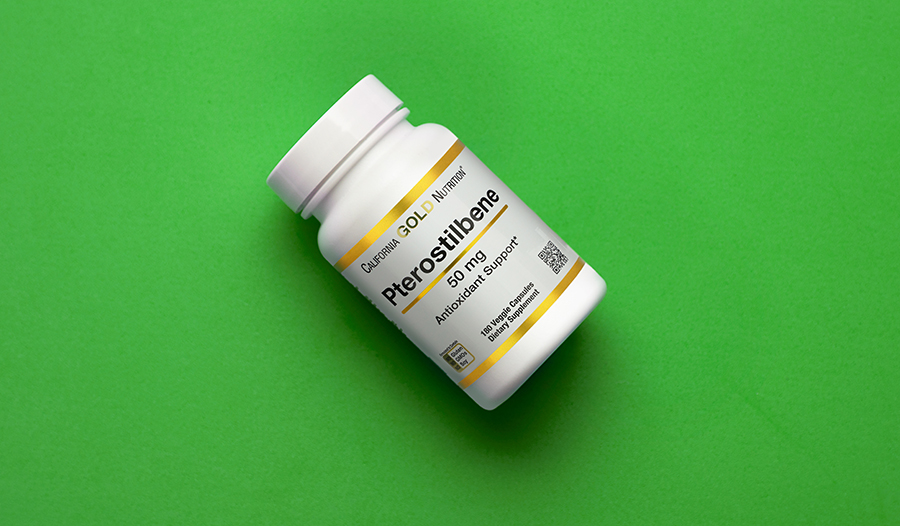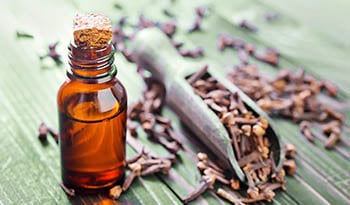What Is Pterostilbene? Here Are 7 Potential Health Benefits
DISCLAIMER:This blog does not intend to provide diagnosis...
- In this article:
- What is Pterostilbene?
- Sources of Pterostilbene
- Health Benefits of Pterostilbene
- Takeaway

What is Pterostilbene?
Pterostilbene is a chemical compound found in plants. It is a polyphenol with a structure similar to resveratrol. However, due to slight structural differences, pterostilbene is more fat-soluble. This difference improves the bioavailability of pterostilbene. In general, animal research has found pterostilbene to have similar yet stronger effects on health than those found for resveratrol.
Pterostilbene is well absorbed, easily distributed throughout the body, and can cross the blood-brain barrier—factors that are unusual for many natural, health-promoting polyphenols. Curcumin, a polyphenol from turmeric known for its potent anti-inflammatory properties, has very poor uptake from the digestive tract. Quercetin, another polyphenol, is also poorly absorbed. This gives pterostilbene a potential advantage over other polyphenols for clinical use.
Sources of Pterostilbene
Pterostilbene was first discovered as a compound in sandalwood. As research progressed, additional sources were found, including blueberries, grapes, peanuts, and Indian kino. The compound is produced in larger quantities in response to plant stressors and fungal infections. Typically, pterostilbene is found in the highest concentrations in fruit, leaves, and heartwood in the plants known to contain it.
Health Benefits of Pterostilbene
A lot of excitement surrounds pterostilbene in the published research. Study authors have acknowledged numerous potential effects, including antioxidant, anti-inflammatory, pain-relieving, blood-sugar-balancing, anti-obesity, and protective effects on the heart and brain. However, human research is still quite limited, even with all the excitement.
1. Antioxidant Effects
Like vitamin C and vitamin E, pterostilbene has been shown to help reduce damage from free radicals. In the published research, pterostilbene has been found to display direct antioxidant effects along with upregulating antioxidant enzymes and defenses throughout the body. It is hypothesized that many of the potential health benefits found with pterostilbene are related to its antioxidant effects.
2. Anti-Inflammatory Activity
Increased inflammatory activity within the body has been associated with a number of chronic diseases. Nitric oxide is a signaling molecule that can play an inflammatory role in immune responses. Cyclooxygenase (COX) is a separate inflammatory signaling molecule that is inhibited by aspirin and ibuprofen. Both of these inflammatory signaling molecules appear to be inhibited by pterostilbene. Excess levels of both enzymes have been related to several chronic diseases.
3. Pain-Relieving Effects
Evidence of pain-relieving properties are still early, and human clinical trials are mostly lacking. While the anti-inflammatory effects described above suggest the potential for pterostilbene as a treatment for pain and inflammation, human data is extremely limited. However, studies in animals have usually corroborated pain-reducing effects. A recent study found reduced swelling and inflammation in a rat model of arthritis. In addition, pterostilbene improved the gut flora composition, decreasing pathological bacteria throughout the digestive tract that may also help reduce inflammation.
A separate rat study also explored pterostilbene in a model of rheumatoid arthritis. When combined with moderate physical activity, the combination proved effective at helping to improve the condition.
While animal studies and cell culture models are interesting, human studies are needed to understand pterostilbene's potential better. A trial in volunteers using 450 mg of pterostilbene a day, a dose known to be safe for human consumption, did not elevate blood levels high enough to produce clinical pain-reducing effects. The authors recommended a dose-finding study to try and establish if a higher dose would be safe and effective for decreasing pain and inflammation in humans.
4. Blood Sugar Balancing Effects
A number of natural compounds appear to hold promise for balancing blood sugar and helping treat diabetes. Cinnamon, berberine, and hibiscus have all shown potential benefits, among other natural compounds. More recently, studies on pterostilbene are suggesting significant promise for helping with blood sugar control and complications of diabetes.
Like many other potential benefits of pterostilbene, animal data strongly suggests benefits for diabetes, yet human clinical trial data is needed. Some of the earliest research administered pterostilbene to diabetic rats. The researchers found that pterostilbene had blood-sugar-lowering effects comparable to the standard diabetes medication metformin.
Consuming high levels of fructose (found in high-fructose corn syrup) has been correlated with increased heart disease, diabetes, and blood sugar problems. As such, it has even been incorporated into animal models, where high doses of fructose can quickly cause blood sugar dysregulation and heart disease. Amazingly, in animals that had all dietary carbohydrates replaced with fructose, pterostilbene was able to prevent diabetic changes.
Additional animal studies of diabetes have uncovered a number of protective effects from pterostilbene. Kidney damage, common in diabetes, is inhibited by pterostilbene. Wound healing is often poor in diabetes. A topical application of pterostilbene improved burn healing in diabetic rats. Another well-known complication of diabetes is loss of hearing. In diabetic rats, pterostilbene was shown to help protect from hearing loss by mitigating free-radical damage.
5. Anti-Obesity Effects
Obesity is rapidly becoming an epidemic throughout the world. And while it is often seen as a lack of willpower to eat less, data suggests other underlying causes, especially since obesity rates have risen in sync over all age groups. Alternative approaches other than just diet and exercise are likely needed to help address the obesity epidemic. Early evidence suggests that pterostilbene may be able to play a role.
Brown adipose tissue is a type of fat found in the body that uses calories to produce heat. White adipose tissue is the fatty tissue associated with weight gain and obesity. Brown adipose tissue is metabolically active, burning excess calories, which can be beneficial for weight loss. Pterostilbene, in animal models, has been shown to upregulate brown adipose tissue's calorie consumption. In addition, pterostilbene was found to help transform white adipose tissue to behave more like brown adipose tissue, burning additional calories.
Interestingly, pterostilbene has also been shown to block fat cell replication and absorption of fat into white adipose tissue. Obesity is also known to increase inflammation. Fat cells produce inflammatory signaling molecules that lead to excess inflammation throughout the body. Through its anti-inflammatory effects, pterostilbene helps to block this inflammatory signaling from fat cells.
The beneficial effects on gut flora, mentioned previously, also appear relevant for obesity. Specific gut flora changes are well known to encourage weight gain. Pterostilbene's effects on rebalancing gut flora also seem to have a part in treating obesity. Animal studies have shown a correction of the gut flora imbalances seen in overweight animals with pterostilbene supplementation.
6. Brain Protecting Effects
Alzheimer's disease rates have been increasing as the world's population continues to age. And unfortunately, there are no accepted disease-modifying treatments. As it currently stands, even with standard treatment, once an individual develops Alzheimer's, it's a slow, inexorable decline that eventually leads to memory loss, disability, and death.
Due to this grim outlook, research has been exploring alternative approaches. Several supplements, including acetyl-L-carnitine, fish oil, and citicoline have research suggesting at least modest benefits for preventing or treating dementia. And pterostilbene may hold promise as well. An initial trial in aged rats supplemented pterostilbene and followed the animals' cognitive function. In the study, pterostilbene was able to reverse age-related cognitive decline. The benefits included improvements in memory.
Acetylcholine is a key neurotransmitter that decreases in dementia. Studies suggest that pterostilbene helps counter this decline by reducing its metabolism and breakdown. Other animal studies in different models have confirmed these findings, showing improved memory performance and increased acetylcholine levels. In a model of accelerated aging in mice, pterostilbene was able to help prevent memory loss and improve inflammation and other signs of dementia pathology. In the same animal model, resveratrol was not effective.
7. Heart Health Benefits
Through a number of mechanisms already described, including antioxidant and anti-inflammatory effects, pterostilbene also appears to help protect from heart disease. Studies have found that, again, in animal models, pterostilbene protects the heart from damage or improves heart function, even during acute heart failure or after a heart attack. Preliminary human trials also suggest potential blood-pressure-lowering effects with pterostilbene. With additional human clinical trials, pterostilbene may show significant heart benefits like a number of other natural compounds, including CoQ10, carnitine, and garlic extract.
Takeaway
Animal studies and preclinical models strongly suggest the significant potential of pterostilbene. The latest research has found antioxidant, anti-inflammatory, pain-reducing, blood sugar balancing, and heart and brain-protecting benefits. And unlike many other promising natural compounds, pterostilbene is well absorbed and well distributed throughout the body. As clinical research in human subjects advances, pterostilbene may be a potential treatment for a number of challenging medical conditions.
References:
- Bray GA. Fructose: pure, white, and deadly? Fructose, by any other name, is a health hazard. J Diabetes Sci Technol. 2010;4(4):1003-1007. Published 2010 Jul 1. doi:10.1177/193229681000400432
- Chan EWC, Wong CW, Tan YH, Foo JPY, Wong SK, Chan HT. Resveratrol and pterostilbene: A comparative overview of their chemistry, biosynthesis, plant sources and pharmacological properties. JAPS. 2019;9(7). DOI: 10.7324/JAPS.2019.90717
- Daniel M Riche, David Deschamp, Michael E Griswold, Corey L McEwen, Krista D Riche, Justin J Sherman and Marion R Wofford. Abstract 617: Impact Of Pterostilbene On Blood Pressure and Other Metabolic Parameters In Adults. Hypertension. 2018;60(1).
- Ding RR, Huang GY, Zhang YJ, et al. Pterostilbene Ameliorates Renal Damage in Diabetic Rats by Suppressing Hyperglycemia with Inhibition of Inflammatory and Fibrotic Responses. Biomed Environ Sci. 2021;34(12):1015-1019. doi:10.3967/bes2021.137
- Gareri P, Castagna A, Cotroneo AM, Putignano S, De Sarro G, Bruni AC. The role of citicoline in cognitive impairment: pharmacological characteristics, possible advantages, and doubts for an old drug with new perspectives [published correction appears in Clin Interv Aging. 2015;10:1625]. Clin Interv Aging. 2015;10:1421-1429. Published 2015 Sep 3. doi:10.2147/CIA.S87886
- Grover JK, Vats V, Yadav SS. Pterocarpus marsupium extract (Vijayasar) prevented the alteration in metabolic patterns induced in the normal rat by feeding an adequate diet containing fructose as sole carbohydrate. Diabetes Obes Metab. 2005;7(4):414-420. doi:10.1111/j.1463-1326.2005.00414.x
- Han Y, Xiang Y, Shi Y, et al. Pharmacokinetics and Pharmacological Activities of Berberine in Diabetes Mellitus Treatment. Evid Based Complement Alternat Med. 2021;2021:9987097. Published 2021 Aug 21. doi:10.1155/2021/9987097
- Hougee S, Faber J, Sanders A, et al. Selective COX-2 inhibition by a Pterocarpus marsupium extract characterized by pterostilbene, and its activity in healthy human volunteers. Planta Med. 2005;71(5):387-392. doi:10.1055/s-2005-864130
- Hu W, Yu H, Zhou X, et al. Topical administration of pterostilbene accelerates burn wound healing in diabetes through activation of the HIF1α signaling pathway [published online ahead of print, 2021 Nov 6]. Burns. 2021;S0305-4179(21)00306-5. doi:10.1016/j.burns.2021.10.019
- Jaacks LM, Vandevijvere S, Pan A, et al. The obesity transition: stages of the global epidemic. Lancet Diabetes Endocrinol. 2019;7(3):231-240. doi:10.1016/S2213-8587(19)30026-9
- Koh YC, Ho CT, Pan MH. Recent Advances in Health Benefits of Stilbenoids. J Agric Food Chem. 2021;69(35):10036-10057. DOI: 10.1021/acs.jafc.1c03699. Epub 2021 Aug 30. PMID: 34460268.
- Kosuru R, Cai Y, Kandula V, et al. AMPK Contributes to Cardioprotective Effects of Pterostilbene Against Myocardial Ischemia-Reperfusion Injury in Diabetic Rats by Suppressing Cardiac Oxidative Stress and Apoptosis. Cell Physiol Biochem. 2018;46(4):1381-1397. doi:10.1159/000489154
- Kosuru R, Rai U, Prakash S, Singh A, Singh S. Promising therapeutic potential of pterostilbene and its mechanistic insight based on preclinical evidence. Eur J Pharmacol. 2016;789:229-243. doi:10.1016/j.ejphar.2016.07.046
- Kumar R, Malik S, Tiwari R, et al. Pathophysiology of Cardiovascular Diseases and the Role of Vitamins, and Herbal Extracts in the Reduction of Cardiovascular Risks. Cardiovasc Hematol Agents Med Chem. 2021;19(2):175-186. doi:10.2174/1871525718666201217102638
- Lacerda D, Türck P, Campos-Carraro C, et al. pterostilbene improves cardiac function in a rat model of right heart failure through modulation of calcium handling proteins and oxidative stress. Appl Physiol Nutr Metab. 2020;45(9):987-995. doi:10.1139/apnm-2019-0864
- Lange KW, Li S. Resveratrol, pterostilbene, and dementia. Biofactors. 2018;44(1):83-90. doi:10.1002/biof.1396
- Liu Y, You Y, Lu J, Chen X, Yang Z. Recent Advances in Synthesis, Bioactivity, and Pharmacokinetics of Pterostilbene, an Important Analog of Resveratrol. Molecules. 2020;25(21):5166. Published 2020 Nov 6. doi:10.3390/molecules25215166
- Manickam M, Ramanathan M, Jahromi MA, Chansouria JP, Ray AB. Antihyperglycemic activity of phenolics from Pterocarpus marsupium. J Nat Prod. 1997;60(6):609-610. doi:10.1021/np9607013
- McCormack D, McFadden D. A review of pterostilbene antioxidant activity and disease modification. Oxid Med Cell Longev. 2013;2013:575482. doi:10.1155/2013/575482
- Milton-Laskíbar I, Gómez-Zorita S, Arias N, et al. Effects of resveratrol and its derivative pterostilbene on brown adipose tissue thermogenic activation and on white adipose tissue browning process. J Physiol Biochem. 2020;76(2):269-278. doi:10.1007/s13105-020-00735-3
- Özdaş S, Taştekin B, Gürgen SG, et al. Pterostilbene protects cochlea from ototoxicity in streptozotocin-induced diabetic rats by inhibiting apoptosis. PLoS One. 2020;15(7):e0228429. Published 2020 Jul 28. doi:10.1371/journal.pone.0228429
- Pan MH, Wu JC, Ho CT, Lai CS. Antiobesity molecular mechanisms of action: Resveratrol and pterostilbene. Biofactors. 2018;44(1):50-60. doi:10.1002/biof.1409
- Pennisi M, Lanza G, Cantone M, et al. Acetyl-L-Carnitine in Dementia and Other Cognitive Disorders: A Critical Update. Nutrients. 2020;12(5):1389. Published 2020 May 12. doi:10.3390/nu12051389
- Rabanal-Ruiz Y, Llanos-González E, Alcain FJ. The Use of Coenzyme Q10 in Cardiovascular Diseases. Antioxidants (Basel). 2021;10(5):755. Published 2021 May 10. doi:10.3390/antiox10050755
- Remsberg CM, Yáñez JA, Ohgami Y, Vega-Villa KR, Rimando AM, Davies NM. Pharmacometrics of pterostilbene: preclinical pharmacokinetics and metabolism, anticancer, anti-inflammatory, antioxidant and analgesic activity. Phytother Res. 2008;22(2):169-179. doi:10.1002/ptr.2277
- Rodgers A, Woodward A, Swinburn B, Dietz WH. Prevalence trends tell us what did not precipitate the US obesity epidemic. Lancet Public Health. 2018;3(4):e162-e163. doi:10.1016/S2468-2667(18)30021-5
- Rui Z, Zhang L, Li X, et al. Pterostilbene exert an anti-arthritic effect by attenuating inflammation, oxidative stress, and alteration of gut microbiota [published online ahead of print, 2022 Jan 20]. J Food Biochem. 2022;e14011. doi:10.1111/jfbc.14011
- Salleh NH, Zulkipli IN, Mohd Yasin H, et al. Systematic Review of Medicinal Plants Used for Treatment of Diabetes in Human Clinical Trials: An ASEAN Perspective. Evid Based Complement Alternat Med. 2021;2021:5570939. Published 2021 Oct 13. doi:10.1155/2021/5570939
- Shang C, Lin H, Fang X, et al. Beneficial effects of cinnamon and its extracts in the management of cardiovascular diseases and diabetes. Food Funct. 2021;12(24):12194-12220. Published 2021 Dec 13. doi:10.1039/d1fo01935j
- Wood AHR, Chappell HF, Zulyniak MA. Dietary and supplemental long-chain omega-3 fatty acids as moderators of cognitive impairment and Alzheimer's disease. Eur J Nutr. 2022;61(2):589-604. doi:10.1007/s00394-021-02655-4

 By Dr. Scott Buesing, N.D.
By Dr. Scott Buesing, N.D.


